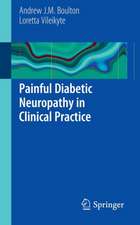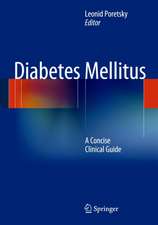Musculoskeletal Disease Associated with Diabetes Mellitus
Editat de Masaaki Inabaen Limba Engleză Paperback – 31 mar 2018
| Toate formatele și edițiile | Preț | Express |
|---|---|---|
| Paperback (1) | 956.58 lei 38-44 zile | |
| Springer – 31 mar 2018 | 956.58 lei 38-44 zile | |
| Hardback (1) | 672.71 lei 38-44 zile | |
| Springer – 15 ian 2016 | 672.71 lei 38-44 zile |
Preț: 956.58 lei
Preț vechi: 1006.93 lei
-5% Nou
Puncte Express: 1435
Preț estimativ în valută:
183.03€ • 191.12$ • 151.15£
183.03€ • 191.12$ • 151.15£
Carte tipărită la comandă
Livrare economică 11-17 aprilie
Preluare comenzi: 021 569.72.76
Specificații
ISBN-13: 9784431566830
ISBN-10: 443156683X
Pagini: 296
Ilustrații: VIII, 296 p. 67 illus., 29 illus. in color.
Dimensiuni: 155 x 235 mm
Ediția:Softcover reprint of the original 1st ed. 2016
Editura: Springer
Colecția Springer
Locul publicării:Tokyo, Japan
ISBN-10: 443156683X
Pagini: 296
Ilustrații: VIII, 296 p. 67 illus., 29 illus. in color.
Dimensiuni: 155 x 235 mm
Ediția:Softcover reprint of the original 1st ed. 2016
Editura: Springer
Colecția Springer
Locul publicării:Tokyo, Japan
Cuprins
Part I. Bone Diseases.-
1. Bone Disease Associated with Diabetes Mellitus: Particularly Focusing on its Contribution to the Development of Atherosclerosis.- 2. Various Kinds of Bone Disease in Diabetes - Rheumatic Conditions.- 3. Fracture Risk in Diabetes.- 4. Mechanism for the Development of Bone Disease in Diabetes: Abnormal Glucose Metabolism.- 5. Mechanism for the Development of Bone Disease in Diabetes: Increased Oxidative Stress and Advanced Glycation end Products.- 6. Mechanism for the Development of Bone Disease in Diabetes: Renal Bone Disease.- 7. Impaired Parathyroid Function and Bone Formation-A Risk for Development of Adynamic Bone Disease to Enhance Vascular Calcification.- 8. Bone as an Endocrine Organ: Diabetic Bone Disease as a Cause of Endocrine Disorder via Osteocalcin, FGF23 Secreted from Osteocyte/Osteoblast.-
Part II. Muscle Diseases.-
9. Overview.- 10. Mechanism of Skeletal Muscle Contraction: Intracellular Signaling in Skeletal Muscle Contraction.- 11. Mechanism of Skeletal Muscle Contraction: Role of Mechanical Muscle Contraction in Glucose Homeostasis.- 12. Ectopic Fat Accumulation and Glucose Homeostasis: Ectopic Fat Accumulation in Muscle.- 13. Ectopic Fat Accumulation in the Liver and Glucose Homeostasis.- 14. Ectopic Fat Accumulation and Glucose Homeostasis: Role of Leptin in Glucose and Lipid Metabolism and Mass Maintenance in Skeletal Muscle.- 15. Evaluation
of Insulin Resistance in Diabetes: Standard Protocol for a Euglycemic-Hyperinsulinemic Clamp Using an Artificial Pancreas.- 16. Sarcopenia in Diabetes Mellitus.- 17. Body Temperature Regulation during Exercise Training.- 18. Clinical Application of Exercise Therapy in Diabetes.- 19. Clinical Application of Exercise Therapy in Diabetes with Chronic Kidney Disease.
1. Bone Disease Associated with Diabetes Mellitus: Particularly Focusing on its Contribution to the Development of Atherosclerosis.- 2. Various Kinds of Bone Disease in Diabetes - Rheumatic Conditions.- 3. Fracture Risk in Diabetes.- 4. Mechanism for the Development of Bone Disease in Diabetes: Abnormal Glucose Metabolism.- 5. Mechanism for the Development of Bone Disease in Diabetes: Increased Oxidative Stress and Advanced Glycation end Products.- 6. Mechanism for the Development of Bone Disease in Diabetes: Renal Bone Disease.- 7. Impaired Parathyroid Function and Bone Formation-A Risk for Development of Adynamic Bone Disease to Enhance Vascular Calcification.- 8. Bone as an Endocrine Organ: Diabetic Bone Disease as a Cause of Endocrine Disorder via Osteocalcin, FGF23 Secreted from Osteocyte/Osteoblast.-
Part II. Muscle Diseases.-
9. Overview.- 10. Mechanism of Skeletal Muscle Contraction: Intracellular Signaling in Skeletal Muscle Contraction.- 11. Mechanism of Skeletal Muscle Contraction: Role of Mechanical Muscle Contraction in Glucose Homeostasis.- 12. Ectopic Fat Accumulation and Glucose Homeostasis: Ectopic Fat Accumulation in Muscle.- 13. Ectopic Fat Accumulation in the Liver and Glucose Homeostasis.- 14. Ectopic Fat Accumulation and Glucose Homeostasis: Role of Leptin in Glucose and Lipid Metabolism and Mass Maintenance in Skeletal Muscle.- 15. Evaluation
of Insulin Resistance in Diabetes: Standard Protocol for a Euglycemic-Hyperinsulinemic Clamp Using an Artificial Pancreas.- 16. Sarcopenia in Diabetes Mellitus.- 17. Body Temperature Regulation during Exercise Training.- 18. Clinical Application of Exercise Therapy in Diabetes.- 19. Clinical Application of Exercise Therapy in Diabetes with Chronic Kidney Disease.
Recenzii
“Japanese authors review both bone and muscular complications of diabetes, but include also diseases of the joints and their relationship to the metabolic control. Mainly for adult endocrinologists, diabetologists and rheumatologists.” (Pediatric Endocrinology Reviews, Vol. 13 (4), June, 2016)
Notă biografică
Masaaki Inaba MD Ph.D.
A professor of Department of Metabolism, Endocrinology, and Molecular Medicine, Osaka City University Graduate School of Medicine.
A professor of Department of Metabolism, Endocrinology, and Molecular Medicine, Osaka City University Graduate School of Medicine.
Textul de pe ultima copertă
The aim of this book is to review the latest findings on musculoskeletal disease associated with diabetes. It has been increasingly recognized that maintaining skeletal health is an important factor in achieving longevity in healthy subjects. Diabetes has been established as a disease independently associated with sarcopenia and increased risk of bone fracture resulting from osteoporosis; therefore, it is reasonable to maintain that musculoskeletal health is important in preserving good health. As either bone or muscle is intimately involved in the regulation of metabolic status, keeping the musculoskeletal system healthy is important for improving abnormal glucose metabolism toward normal levels and is vital, as well, for maintaining normal activities of daily living. Muscle is a target of insulin for enhancing the entry of glucose; thus it is conceivable that sarcopenia and muscle containing fat streaks causes insulin resistance in diabetic patients. Furthermore, bone is an organ that regulates Ca and Pi levels in serum by releasing or resorbing Ca and Pi to and from bone tissue. It is now known that bone is a definitive endocrine organ for regulating glucose metabolism and Pi metabolism by secreting osteocalcin and FGF-23 from osteocytes/osteoblasts. Readers will learn of the recent findings in this area, and this book will benefit physicians who deal with diabetes, particularly orthopedists and bone specialists, as well as all physical therapists.
Caracteristici
Reviews the latest findings on musculoskeletal diseases associated with diabetes Maximizes reader insight into the mechanisms and clinical applications for bone and muscle diseases Provides comprehensive knowledge for treating musculoskeletal diseases caused by diabetes Includes supplementary material: sn.pub/extras









